Grounded No More Nonprofit honors





















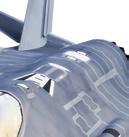








100-year-old WWII veteran


Grounded No More Nonprofit honors






























100-year-old WWII veteran

A2023 F-150 Lightning 4x4 Super Crew pickup with the heart of a fighter jet brought in $535,000 for the Luke Air Force Base Honor Guard Facility fund during the Barret-Jackson auto auction in January.

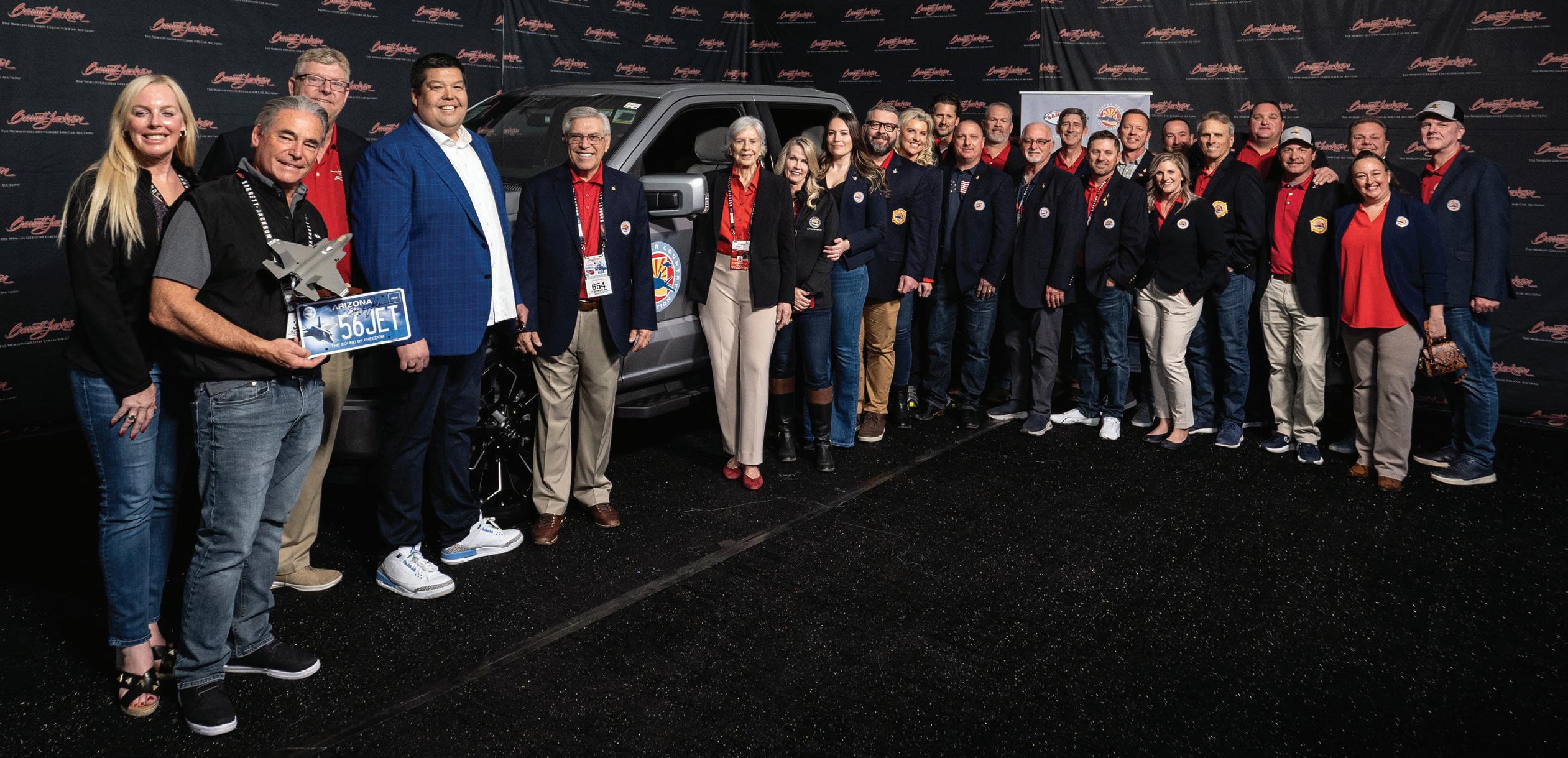
The Fighter Country edition electric pickup sold for $275,000 and was inspired by the F-35 Lightning jet.
“Fighter Country Foundation is honored to be one of the five charities in this year’s Barrett-Jackson auction,” says Ron Sites, Fighter Country Foundation president and chief executive officer.
“Our outstanding supporters at Sanderson Ford and Barrett-Jackson raised $275,000 for our Honor Guard Training Facility Fund and triggered a matching $250,000 pledge from our friends at IDM Companies.”
An anonymous donor at the auction gave
another $10,000 after hearing of the project.
Barrett-Jackson regularly auctions vehicles to support charitable initiatives, helping raise over $149 million for charity to date.
“After being out at Luke Air Force Base
and seeing what these men and women do, it is an honor to help them,” says Craig Jackson, chief executive officer and chairman of



Publisher
Steve T. Strickbine

Vice President

Michael Hiatt
Associate Group Publisher
Laura Meehan, 623-777-1042 lmeehan@star-times.com



Executive Editor
Christina Fuoco-Karasinski 480-898-5631 christina@star-times.com

Contributors


Elias Carrero, Noah Damon Coger, Susan Gladstein, Jakob Hambright, Mason Hargrove, John Heckenlaible, Josh Ortega, Bill Quehrn, Dominic Tyler
Graphic Design
Veronica Thurman vthurman@timeslocalmedia.com

Design/Production Supervisor Shannon Mead smead@timeslocalmedia.com
Advertising Representatives Barbara Duran, 623-847-4608 bduran@star-times.com
Connie Williams, 623-847-4601 cwilliams@star-times.com

Circulation

to active duty & retired military personnel both on Luke Air Force Base and in the surrounding areas. It is also direct-mailed to the nearly 2,000 members of the Fighter Country Partnership, as well as distributed to businesses on Luke Air Force Base and in the surrounding areas. For further circulation information regarding this publication or any others in the Times Media Group family, please contact Aaron Kolodny at aaron@ timeslocalmedia.com


Sound of Freedom sets high standards to ensure forestry is practiced in an environmentally responsible, socially beneficial and economically viable manner. This issue was printed on recycled fibers containing 10% post consumer waste, and with inks containing a blend of soy base. Our printer is a certified member of the Forestry Stewardship Council, the Sustainable Forestry Initiative, and additionally meets or exceeds all federal Resource Conservation Recovery Act standards.

Statements, opinions, and points of view express written consent by the writers and advertisers and are their own, and do not necessarily represent those of the publishers, editors, or Sound of Freedom sta . Although Sound of Freedom has made every e ort to authenticate all claims and guarantee o ers by advertisers in the magazine, we cannot assume liability for any products or services advertised herein. No part of Sound of Freedom can be reproduced or transmitted in any form without the express written consent of the publisher. The publisher reserves the right to accept or reject any editorial or advertising matter at any time.






































































We have a big jackpot winner about every five minutes! And you could be next with more of the newest, hottest slots and table games to choose from. Diamond Rewards gives you more choices and more rewards at all four of our fun locations. Plus, always expect more great food, friendly service and good times!











GOAL FROM PAGE 2
Barrett-Jackson.
“We’re proud of the legacy we’ve earned as a company known for supporting organizations that help our military veterans. Together with the generous donors and bidders, we’re improving the lives of countless Americans across the country.”



The F-150 pickup auction winner, Lance Mortensen, is no stranger to aviation. A pilot himself, Mortensen says he is thankful to have Luke Air Force Base nearby.
“It’s a wonderful cause, supporting our troops, supporting the Air Force,” Mortensen says. “The F-35 is incredible. I can tell you that the (airmen) who fly this airplane are absolutely incredibly brave, strong, and the most intelligent guys on the planet. I think we should all support the military and those who support the families after the fact, and we should never lose sight of that.”
Although getting the vehicle to the auction block almost didn’t happen, David Kimmerle, Sanderson Ford chief executive officer, was determined to make it happen.
“A few months ago, we were thinking about the Barrett-Jackson. I was thinking of the F-35 Lightning II (jet), and here we have a Lightning (F-150) pickup, but it’s not available anywhere,” Kimmerle says.
“I had ordered one for a customer, and he decided not to take it. Problem was they wouldn’t start building it until December 3 and there was no way it’d get from the factory in time for the auction.”
Kimmerle contacted a man he knew at the plant in Dearborn, Michigan. Although he was no longer the manager there, he helped get it quality checked and transported to Arizona by truck instead of by rail — saving crucial time.
“We only had a couple of weeks to make it in time,” Kimmerle says. “Barrett-Jackson is always so great when it comes to support of the military.”
And it made it — just in time.
“All these people came together to make it happen,” Kimmerle says. “All the things Fighter Country Foundation has done is just amazing and we’re blessed to be a part of it.”
After the auction, Kimmerle says he was elated it all fell into place.
“This is an amazing thing when you look at all the people around that are touched by the military and what they do at Luke Air Force Base and then to see the generosity today, it’s just overwhelming,” Kimmerle says. “Car guys never have a loss for words, but I’m there. We appreciate it.”
Kimmerle’s wife, Jill, is also grateful everything came together to help Fighter Country Foundation.
“Thank you ever so much. We appreciate all the help we can give to the families at Luke Air Force Base,” she says.
The donations received so far will help toward the goal of $2 million to build a dedicated Honor Guard Training Facility. It will include an air-conditioned 3,300-squarefoot space for training, storage and administration, and an adjacent covered area for longer detail training and drill.
“We are free because of our military. It’s that simple,” Jackson says.


Credit Union West held a check presentation on January 20 for its final EmployeesCARE donation of 2022. Credit union employees donated $5,307.49 to Arizona Helping Hands, a local nonprofit organization that provides necessities for children in foster care.
Arizona Helping Hands was chosen for the level of care they provide children in Arizona’s foster care system.


Arizona Helping Hands became a nonprofit organization in 1998 and has served tens of thousands of children with a mission to provide essential needs for kids in foster care through programs promoting safety, permanency and health.
In addition to providing basic needs and back-to-school supplies, Arizona Helping Hands makes sure that foster children are
celebrated on their birthday. The organization creates personalized birthday packages filled with donated toys, games, books and puzzles through their Birthday Dreams Program.
To support these programs, Credit Union West leaders and staff presented Arizona Helping Hands with the donation check at their corporate office. The donation was made possible by Credit Union West team members who fund the EmployeesCARE Program, which raises money for a nonprofit organization selected by employees each quarter.
To further inspire staff to give, President and CEO Karen Roch matched the donation with her personal funds.
“Credit Union West is so excited to help fund the programs that Arizona Helping Hands provides to foster children in our








community,” Roch says. “I love seeing our employees give so generously to such a vital organization in our state.”
This brought the total of donated funds to over $22,000 for the year.

Credit Union West was founded in 1951 as Luke Federal Credit Union. Originally located on Luke Air Force Base, the organization’s mission was to enhance the lives of military members and their families through being a trusted provider of financial services.

Today, Credit Union West embraces the same commitment to the military and now has expanded to Maricopa, Pima, Pinal, Yavapai, Yuma, Mohave, Coconino, Cochise, Navajo, Apache and Gila counties.

Credit Union West serves over 86,000 members with more than $1.1 billion in assets.





































480-922-1968


 56th Fighter Wing Public Affairs
56th Fighter Wing Public Affairs
The 56th Maintenance Group held its annual weapons load competition at Luke Air Force Base on February 3.

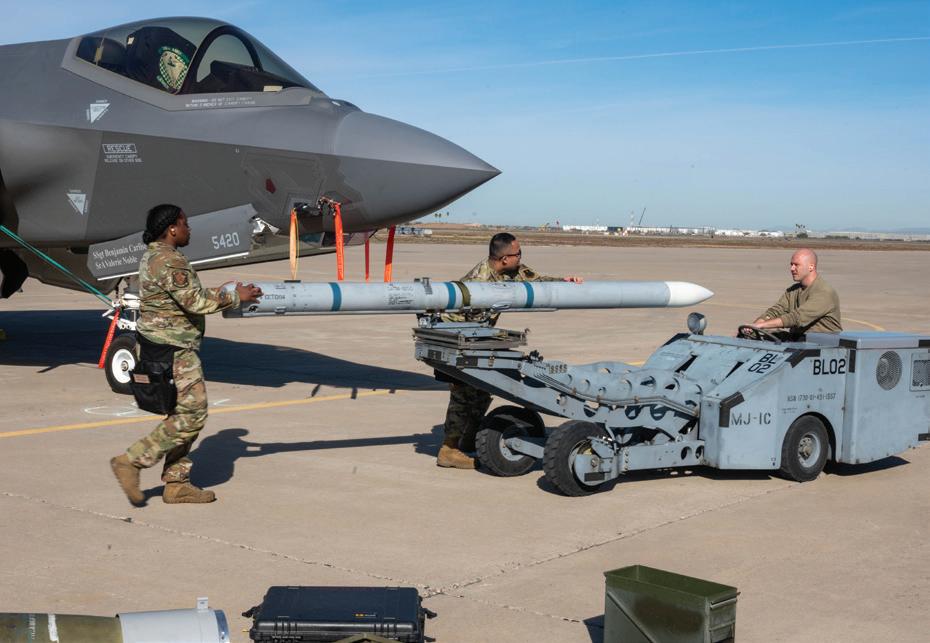
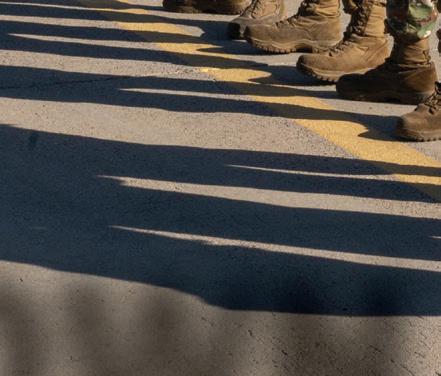
This one-day competition allowed members of various aircraft maintenance units including their international counterparts to showcase the best load crews Luke AFB has to offer.
“Load competitions put the spotlight on the load crews here at Luke AFB,” says Tech. Sgt. Sonny Hicks, 56th MXG weapons standardization team member. “It allows them to showcase their skills, their talents, and all the hard work they’ve put in all year.”

Instead of written evaluations, the weapons career field decides quarterly and annual award winners by load
competitions. Six crews from various aircraft maintenance units in the 56th MXG participated in the competition.
“Crews are selected based on recommendations by their supervisors, their load stats, and what they’ve done throughout the year,” Hicks says.
“Once their supervisors push them up, we look at their stats and their performances and decide if that crew can compete or not.”
Load crews are evaluated on four separate evolutions, including a toolbox inspection, uniform inspection, knowledge test and the load competition.
“The crews need to show that they are an all-around package,” Hicks says. “Yes, they can load, but we want to make sure that they keep themselves and their tools accounted for.”
For the load crews who are participating in the events, the competition allows them to continue developing their proficiency while having some fun.
“They are so much fun,” says Airman 1st Class Jacob Robinson, 63rd AMU aircraft armament systems specialist. “You obviously have the pressure, and it is scary, but being able to compete against other crews is a blast.”
JAKOB HAMBRIGHT
56th Fighter Wing Public A airs
For the airmen at Luke Air Force Base, the mission to train the world’s greatest ghter pilots revolves around two aircra : the F-16 Fighting Falcon and F-35 Lightning II. Geo-separated, the 550th Fighter Squadron based at Kingsley Field, Or-
egon, and assigned to the 56th Fighter Wing, extends the mission to include the F-15C Eagle.
Attached to the 173rd FW, the 550th FS serves as the U.S. Air Force’s only formal F-15 training unit and is the largest total force integrated active association in the Air Education and Training Command.
“Our mission is to train the world’s greatest F-15C ghter pilots,” says Lt. Col. Paul Baker,
commander of the 550th FS. “We also focus on developing and training our multi-capable enlisted support force of the 550th.”
As the active-duty F-15C Formal Training Unit mission transitioned to the Kingsley Field, the 550th FS was activated.

“ e 550th executes the TFI construct to a high degree of success,” Baker says. “We’re able to provide valuable insight and knowledge to the 56th FW on something that is ingrained


Roman’s daughter Myra Curtis took over the business in 2015 with the goal of continuing her daddy’s legacy of providing a fun, local community gathering spot. “If you don’t have fun at Roman’s, it’s your own fault”, laughs Curtis. Roman’s Oasis is a destination with entertainment every night of the week. Live Bands, DJs, Karaoke, Event Poker, both Couples and Line Dance Lessons, and Trivia. Menu items include such delicacies as coconut crusted shrimp, calamari, seared Ahi tuna, green chili chicken pasta and ribeye steaks... as well as ‘fried wonderfuls’.
Reservations for dinner or parties can be made throughout the year; including wedding receptions, birthday parties, and company events (623-512-0852).
As the city grows, so must the roadways. Therefore, Yuma Road is slated to be widened in the near future to accommodate current and future growth. A new building will be established near the current location, on the same property, prior to the existing building being torn down. Since Roman had help from his contemporaries with building and decorating the current building; so Myra wishes to continue the theme of a ‘community build’ when taking down current décor and then placing it at the new building. Community members are encouraged to sign up at Roman’s to assist.
The next generation of Roman’s family is firmly entwined in the business, as Myra’s

Open EVERY DAY from 11am-2am Happy Hour EVERY DAY from 3-7pm Kitchen Hours Sun-Thurs from 11-9pm Fri & Sat 11am-10pm




16825 W Yuma Rd
Goodyear, AZ 85338


(623) 932-0922

in how the U.S. Air Force operates as a total force.”


While operating at Kingsley Field, the 550th FS has seamlessly integrated with various units in the 173rd FW, allowing the 550th FS to maintain itself while being separated from the 56th FW.
“The 550th Fighter Squadron is an integral piece of the 173rd Fighter Wing,” says Col. Lee Bouma, 173rd FW commander. “When you look across our wing, it is impossible to tell who is a guardsman and who is active duty.”
The 550th FS works closely with the 56th FW to accomplish the mission.

“A couple things that make the 550th FS unique compared to a normal fighter squadron at Luke is that we are a geographically separated unit,” Baker says. “We have a fantastic relationship with all of the groups and leadership at Luke AFB, so anytime we need help with something or a specific resource, we can reach back and get the support we need. The other difference is that we are more of a Fighter Generation Squadron having a mix of 31 different AFSCs integrated in multiple groups and squadrons on Kingsley Field.”
As the F-15C begins to be pulled from active service, Baker looks at the potential future for the 550th FS.
“As the F-15 sunsets at Kingsley Field and a future mission is announced for this base, the 550th will play an integral role in helping the transition,” Baker says. “We will bring in experienced active-duty pilots, maintainers and support specialists that will have recent
skill, knowledge and understanding of the next platform. These members will likely help Kingsley in a smooth transition to the future mission.”
Even though they are not located at the same base or even in the same state, the airmen of the 550th FS and the 56th FW have the same goal of training the world’s greatest fighter pilots.
The Luke Air Force Base Veterinary Treatment Facility plans to expand its services by moving into an upgraded facility located across the Block House in March.
The current facility located outside the Lightning Gate is able to provide generalized wellness and basic sick calls to the dogs and cats of active duty, reserve and retired service members and their dependents.
“We’ll have three exam rooms,” says Dr. Rachel Hallman, Luke AFB Veterinary Treatment Facility veterinary medical officer.
“We’ll have an extra room, a kennel room, surgery room, a break room, and we can let
clients in because there will be space to put them.”
In September 2022, Hallman was hired to provide full-time support to the facility which closed sporadically due to a lack of staff. Now she seeks to spread awareness of the current and future services the facility provides.
“We are here for service members and taking care of your family.”
“The treatment we offer is incredibly important, because if you are worried about your dog, you’re not going to do well at your job,” Hallman says. “We are here for service members and taking care of your family.”
Hallman said in addition to increased access to treatment for pets, the facility is looking to also alleviate financial stress that comes from medical care.
“We’re a small clinic, but we have a very personable staff,” says U.S. Army Sgt. Ambria Crooks, Luke AFB Veterinary Treatment Facility noncommissioned officer in charge. “We work hard to make sure your animals are taken care of.”

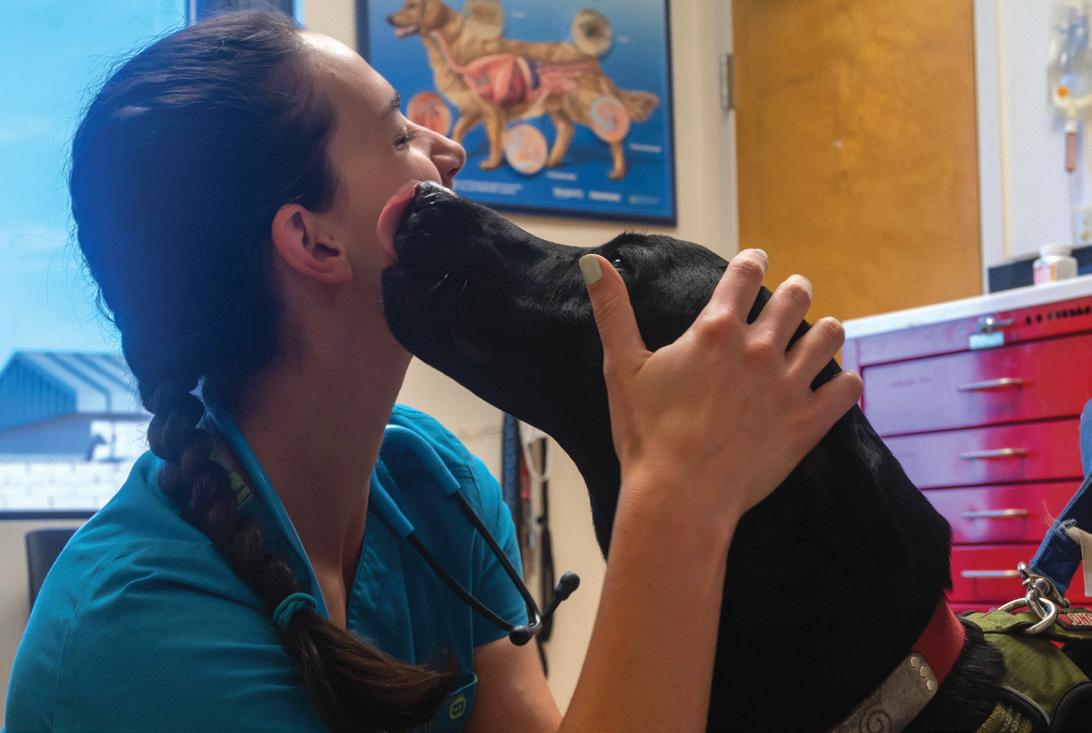
The facility open is 8 a.m. to 4 p.m. Monday to Wednesday with options for medicine pickup on Thursday.
“I’m full time, so we can be open four days a week,” Hallman says. “We’re looking to be open on Fridays.”
The facility staff can care for pets other than cats and dogs on a case-by-case basis. Hallman said the best thing to do is call and ask for specifics regarding what care is available for your pet.

“There are so many treatment options that do not have to be a financial strain,” Hallman says. “We are not here to make a profit. We are treating you, because you are family.”
For additional information, call the Luke AFB Veterinary Treatment Facility at 623856-6354.
From a dark windowless room beneath the air control tower, the 56th Operations Support Squadron radar approach control team vigilantly monitors Luke’s airspace.
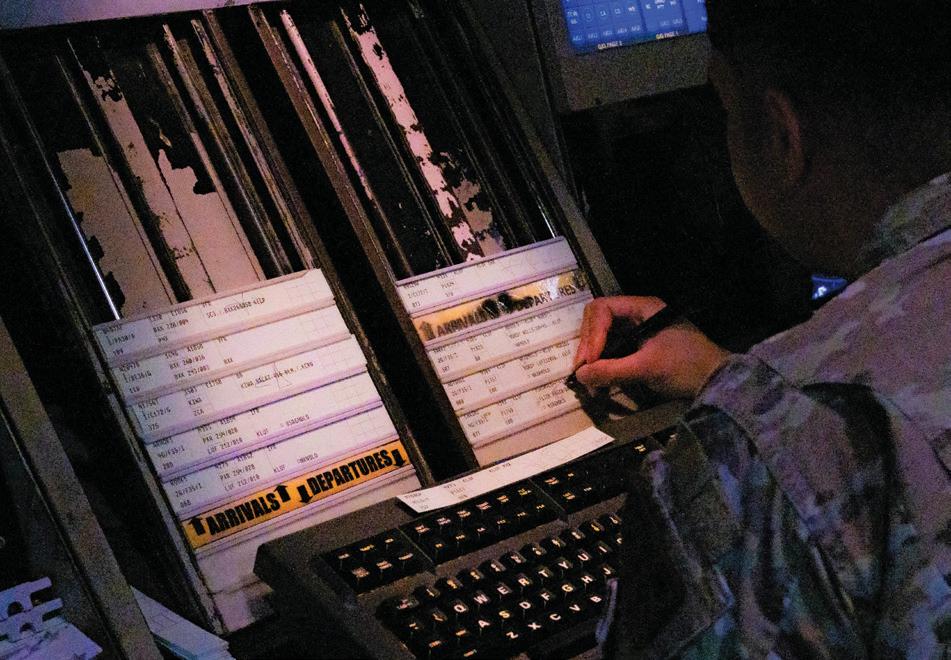

As Luke fighter pilots take to the skies, the RAPCON team coordinates and monitors the flight paths of military and civilian aircraft surrounding 8,000 cubic miles of airspace outside Luke’s local area.
“In simple terms, we make sure pilots get from point A to point B without flying into another aircraft’s flight path,” says Senior Airman Kristen McQueen, 56th OSS air traffic control specialist.

Celebrate Arizona’s favorite season with delicious spring specials every day of the week at The Wigwam’s restaurants.


Enjoy the resort’s signature restaurant Litchfield’s with half-off select bottles of wine every Wednesday. Red Allen’s Bar & Grill is extending its lively atmosphere with Happy Hours Monday through Friday from 3 to 6pm, and live music every Tuesday 7 to 9pm. Plus, Wigwam Bar is ready-for-fun with live music on Fridays and Saturdays and Happy Hours Sunday through Thursday from 4 to 6pm.
wigwamarizona.com | 877.881.9405
“While the air traffic controllers in the tower monitor 5 miles out for landing and takeoff, the rest of the air-
SEE RAPCON PAGE 20




Let us help you buy or sell your property anywhere in Tucson, Vail, Oro Valley, Green Valley, Marana, Sahuarita, Benson or Sierra Vista. We are your rescource for all VA related real estate transactions as well as Conventional, USDA and FHA!



Let us help you buy or sell your property anywhere in Tucson, Vail, Oro Valley, Green Valley, Marana, Red Rock, Sahuarita, Benson or Sierra Vista. We also do referrals to great partners in the Phoenix area! We are your rescource for all VA related real estate transactions as well as Conventional, USDA and FHA!

For any rental and property management needs, please contact me for more information!!
For any rental and property management needs, please contact me for more information!!

We are the one-stop source for all of your BUYING, SELLING and RENTAL needs!
We are the one-stop source for all of your BUYING, SELLING and RENTAL needs!
FrazierRay Alston USAF 1st Sgt, Retired Designated Broker

520-820-2010
If you are considering a career in Real Estate Call me for an interview. Always looking for motivated agents!

space is left for the RAPCON team.”





This monitoring requires constant communication with Phoenix approach controllers as well as other airports and aircraft training centers across multiple states surrounding Arizona. This high volume of air traffic makes the Luke RAPCON team the 10th busiest controllers in the Air Force.


“It’s like playing 3D chess,” says Senior Airman Tyler Turnbull, 56th OSS air traffic control specialist. “Before we make a decision, we have to factor in every aircraft that might conflict with the next aircraft’s line of flight in the future. We have to stay focused and plan multiple steps in advance.”
While this job may be a daunting task to some, monitoring radar and coordinating aircraft is a team effort, with every airman playing a specific role in the mission.

“Anytime an approach control Airman is watching the scope, there’s a team backing them up,” McQueen says. “There’s a person to their left called the ‘assist’ who’s there for anything the approach control needs. Behind the assist is the ‘coordinator,’ who stays in contact with the tower for backup. Behind all of them is the ‘watch supervisor,’ ready to back up the whole room. We have to have each other’s backs in that room at all times.”
The RAPCON team is always on call for weekend flights and big events that require a large number of departures, keeping military and civilian passengers safe. Though it can often be a highly demanding job, Senior Airman Nicholas Anderson expresses his feeling of working while under pressure.
“One thing I love is the intensity of the job,” says Anderson, 56th OSS air traffic control specialist.
“We have to stay vigilant at all times. You’ll be staring at the radar, tracking multiple aircraft, calculating multiple flight paths, and communicating with multiple pilots and controllers. Next thing you know, hours have flown by.”
Many moving parts are required for the U.S. Air Force’s largest fighter wing to continue fulfilling the mission. RAPCON plays a key role in that mission, being the eyes of our fighters while they train to be the world’s greatest fighter pilots and combat-ready airmen.

 BY AIRMAN 1ST CLASS MASON HARGROVE 56th Fighter Wing
BY AIRMAN 1ST CLASS MASON HARGROVE 56th Fighter Wing
The 56th Fighter Wing hosted more than 50 honorary commanders during an immersion at Luke Air Force Base on January 31.

The purpose of the event was to further promote mutual understanding between HCCs, and 56th FW leadership and personnel.
The HCC program intends to pair up base leadership with community leaders who have limited or no knowledge about the Air Force. Base leaders can showcase their capabilities and programs while encouraging partnerships between the Air Force and local communities.
“Luke AFB is part and parcel to the community in which we reside,” says Brig. Gen. Jason Rueschhoff, 56th Fighter Wing commander. “It’s very important for us at Luke to remain transparent with the community that we’re a part of.”
During the event, the 56th Training Squadron provided HCCs an opportunity to test an F-16 Fighting Falcon training simulator to gain insight into F-16 pilot training operations and their importance within the Department of Defense.


“It’s a great way for us to understand what the base does and what the mission is,” says Thomas Maynard, honorary commander. “Coming from a military family, I thought it was a good opportunity to learn more about the Air Force and how it works.”
HCCs are projected to return in March for an aircraft display hosted by the 56th Operations Group and the 56th Maintenance Group.






It started when Kathy Davidson read a newspaper article about a local nonprofit and culminated the day before her father-in-law Carl Davidson turned 101.
On the eve of his birthday, Carl embarked on a journey that took him into the wild, blue yonder.

Kathy reached out to Grounded No More Inc. CEO Tony Anger and, with his help, Carl on January 21 caught a free half-hour Honor Flight at Falcon Field in a World War II trainer aircraft that he even piloted for few minutes.

“Oh, I had a good time,” Carl says. “It’s a nice flight, and the terrain has changed so much since I flew over during World War II.”
The Salem, Illinois, native joined the Army Air Corps in September 1942. He tested into a commission as a second lieutenant and spent just over three years in the service before he left as a captain in December 1945.
Carl finished training and got assigned as a training instructor to Luke Army Airfield — now Luke Air Force Base — preparing hundreds of young men for aerial combat in a variety of single-engine fighter planes like a combat glider nicknamed “The Flying Coffin” as well as a B-24 Liberator bomber.

After leaving the service, Carl stayed in Phoenix “for the weather” and started his own paint business that is now owned by his son, Terry Davidson.
Despite the chilly conditions the day of his flight, Carl was all smiles from tarmac to taxi to takeoff and back and shared what a “tremendous job” Grounded No More has done a for him and other veterans.
“I am very appreciative of this organization for putting this altogether and produce this for the many servicemen that deserve it more than I do,” Carl says.
With his wife, four children, seven grandchildren and four great-grandchildren in attendance, as well as the Desert Young Marines
from Glendale, Carl says he was taken aback by the fanfare surrounding him.
“This is a surprise and more than I could comprehend,” Carl says.
Young Marines — a youth program that mentors boys and girls from ages 8 to 18 through military discipline and education — provided a color guard ensemble for Carl that day.
Mary Lou Davidson, Carl’s wife of 62 years, anxiously watched his flight, saying, “That’s enough.”
But she was happy to see her husband enjoy himself again in the skies.
“I think it’s great for him to have this, to be able to see other fliers, and (he) probably thought he was never really going to fly again. After all, look how old he is,” Mary Lou says.
“He was really surprised and really happy to have this,” she adds. “But he didn’t think it needed to be such a fuss.”











Mary Lou says he has always put others before himself, like when his younger brother died last June and he mustered the strength to fly to Illinois twice in one week — once to see him and again for the funeral.
“You’ll never find another one like him. One in a million,” Mary Lou says. “And he’s very thoughtful for everybody.”

Carl’s son Terry Davidson says he knew his dad would get excited before they told and how much flying means to him.
“I knew dad would be excited, and he was when we called him and talked to him,” he says. “And it’s a real honor for him to be back in the air again and even get the chance to fly the plane a little bit.”
Kathy says she originally wanted to sign Carl up to take part in the Honor Flight Network program that flies veterans back to Washington, D.C., to visit the memorials dedicated to their service, but “it never worked out.”
“So, when I saw this, and I knew it was local, and it was something that was just, you know, half an hour flight, I contacted (Grounded No
More Inc. CEO) Tony Anger and I asked about it, and then we asked Carl if he would be interested, and he was very interested,” Kathy says.

Kathy says she held back tears watching everything unfold that day, especially because she wanted to do something like this for her own father, an Air Force veteran, who passed away before she could do it.
Above all, Kathy says she’s most impressed with Carl’s strength at and staying as ambulatory at his age.
“At 101, I don’t know if I’d feel comfortable doing this, and he was ready to go,” Kathy says.
The camaraderie in the veteran community that makes something like this possible also impressed Kathy, though she feels more should be done for veterans.


“It’s scary that there are veterans on the streets and people who really need help, and I think that we all need to try to do more for them,” Kathy says. “I mean, this is wonderful, but we have a good family and he has a good life but a lot of the veterans don’t, and they fought for you and me, too.”
Anger has done his best and taken more than 500 veterans on a free flight in his


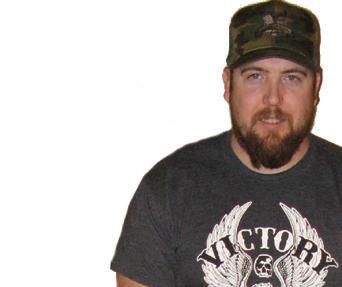
Fairchild PT-26 propeller plane named “Amazing Grace.”
“When I hear World War II, they get moved right to the front of the line,” Anger says. “They get a day all by themselves.”

Of the more than 20 WWII veterans Anger has taken up, he says this sits up near the top with Carl’s backstory, his physical capability at his age, and his flight skills.
On the tarmac, Carl needed little help getting into and out of the plane and in the air, Anger says Carl obviously had not forgotten his flying skills.
He says Carl he flew “flawlessly” with coordinated turns and the proper altitude and that he let the flight last longer than the usual 30 minutes because “we were having so much fun that I didn’t want to come back.” Anger says, adding:
“If I didn’t know any better, I would have said, ‘Yeah, you can go fly it yourself,’ because he did that good.”













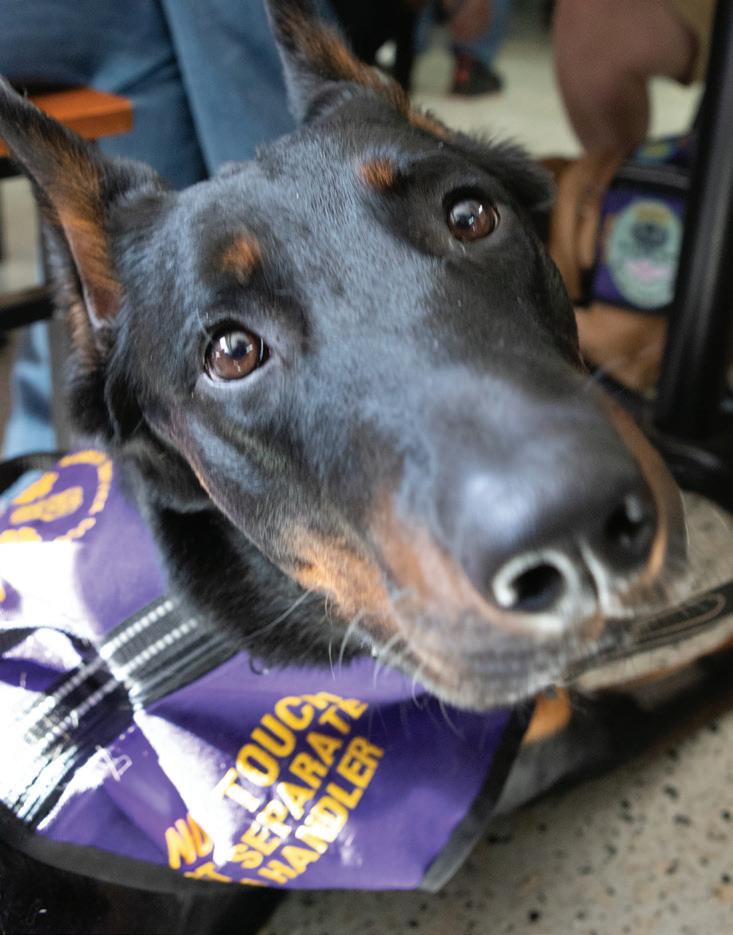
The Sons of the American Legion Pat Tillman Squadron 117 in Phoenix hosted a dart tournament with 66 throwers, raising $34,000 for veterans and their dogs in training, Fisher House Foundation and child welfare nonprofits on February 4. More than 120 people attended. Event sponsors included the Hideaway, Roadhouse, City Plumbing, Cave Creek Cooling, Javier Electric, Viking Bond Service, American Premium Vodka, Sierra Window Tinging, Fairway Mortgage, Tom’s Thumb, Grangers, Jester MC, Illusion Cars, Elliot Electric, Axemen MC, Restricted Republic, GP Motorplex, Take It for Granted, UPS Store and Donny Chavez Photos. Photographer Cassandra Tomei was there to capture the event.



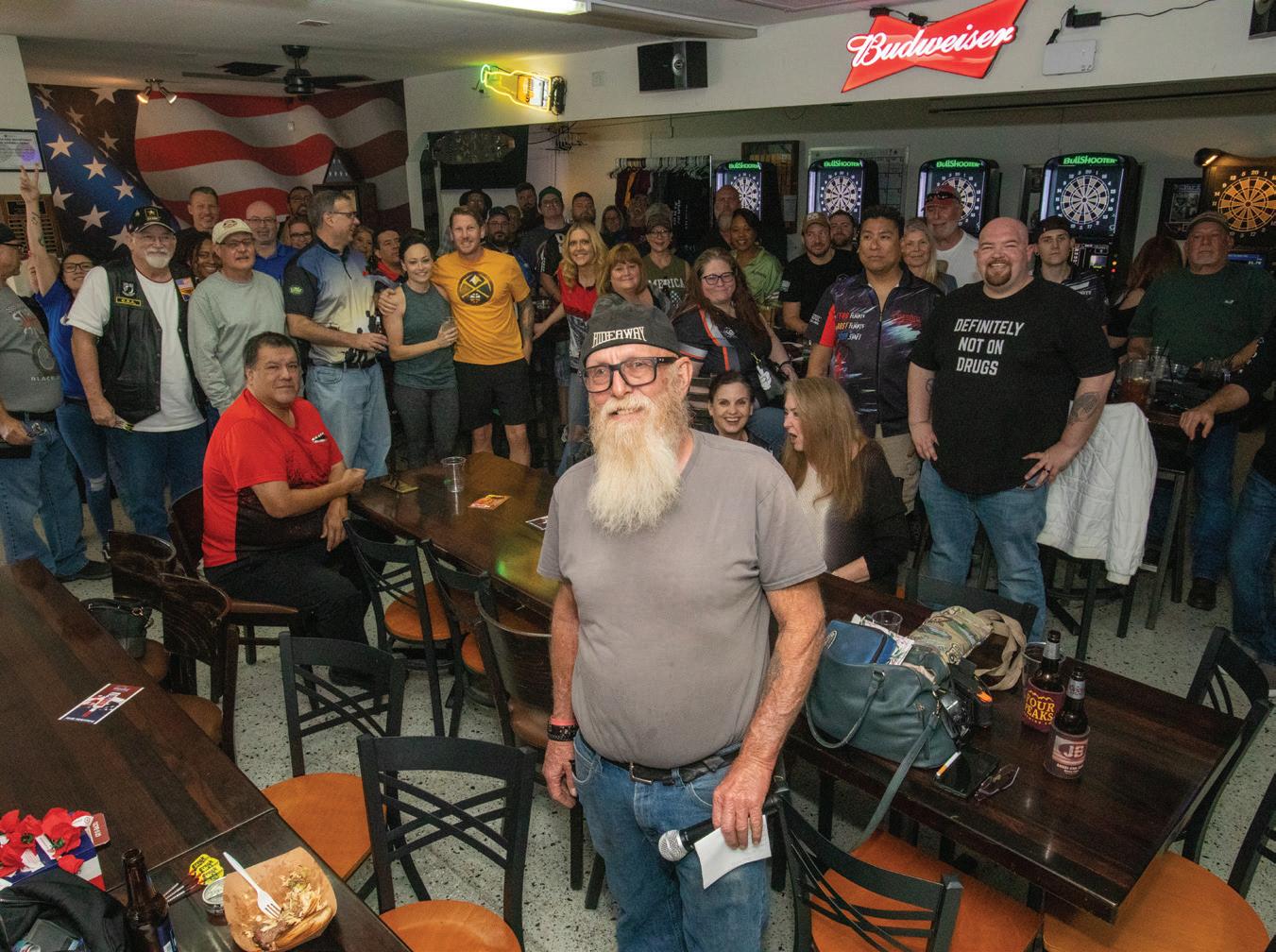



Acollection of fully restored historic military airplanes is the central feature for visitors to Airbase Arizona Flying Museum. When guests visit, they see the planes, but they are encouraged to observe the mannequin by the door to the maintenance hangar hallway.

That mannequin represents a B-17 bomber crewmember preparing to embark on another mission over Europe between 1942 and 1945.
Often in their mid-20s, some as young as 19, those crewmembers knew their next mission might be their last. On mission after mission, they watched other planes in their formations explode and crash. They knew the difference between death or capture and the safe return to base was simply a matter of luck.
They knew Nazi fighter planes and anti-aircraft fire could instantly turn their plane into a blazing coffin. But before they encountered a single enemy obstacle, other dangers awaited them — notably the elements and the chance of accidents or equipment failures of their planes.
B-17s attacked at altitudes exceeding 30,000 feet where the temperature could be 40 degrees or more below zero. While the plane’s durability was legendary, B-17s offered little creature comfort. The so-called Flying Fortresses had no insulation and no interior heat to keep the fliers from freezing to death in seconds. When bomb bay doors opened to release the bombs, sub-zero air rushed in. The young crewmembers’ only protection came from the layered flight suits they wore.
On mission days, crews were typically awakened at their bases in England around 2 a.m. for breakfast and briefing. Already chilly in the English morning mists, it was time then to slide into winter long underwear, two pair of heavy wool socks — if they were available — and then step in to an electric blanket type body suit that plugged into receptacles in the plane. The suits didn’t provide comforting warmth, but they did help prevent boys from freezing to death.
Next they put on a heavy wool-lined leather flying suit and wool-lined leather boots over their shoes. Once in the air, they added a wool-lined helmet, cumbersome headsets,
flack vests, a throat microphone, an oxygen mask, a parachute harness, and heavy woollined leather mittens over silk gloves. The silk gloves were needed when the leather mittens had to be momentarily removed to use a pencil to navigate or to clear a machine gun jam. Bare hands would stick fast to the viciously cold metal.
Hundreds of planes were often launched together for a mission creating a bizarre sky dance of the ponderous four-engine behemoths sliding into their assigned positions for the attack. The process could last for an hour. Collisions between planes often resulted in fatal accidents during this harrowing time.
Once in their formations, pilots and crews checked their planes for mechanical problems that could result in a crash or inability to defend themselves against enemy assets. If they survived all that — and the several-hour flight to their target that day — they were finally ready to face the enemy.
Initially, it was believed that tight box formations of B-17s bristling with 13 machine guns could defend themselves against enemy aircraft without the need for escort fight-
ers. That proved to be a disastrous mistake.




Norden bombsites in use during the war required absolute uninterrupted straight and level flying over targets creating indefensible, perilous and terrifying moments for the bomber crews. The box formations made them sitting ducks for anti-aircraft ground fire and flack explosions capable of tearing a B-17 apart in seconds. Flack accounted for about 71% of Allied aircraft losses.
For most of World War II, the bomber crews of the 8th Air Force over Europe had about a 30% chance of surviving the 25 missions they were ordered to complete. Over 26,000 8th Air Force crewmembers alone were killed in combat over Europe. Thousands more suffered life-shattering injuries, death in accidents, or brutal incarceration in Nazi POW camps.
Despite the horrific odds against them, it was the air crews that paved the way for D-Day and eventual Allied victory in Europe in World War II.
Airbase Arizona Flying Museum at Falcon Field in Mesa offers visitors 100 years of military aircraft history with around 15 planes on hand at any time, including six that can
take passengers on unforgettable rides. Information about museum events, group tours or flight bookings can be found at the museum’s website.
Visitors will certainly be impressed by the magnificent display of airplanes, engines and artifacts. But please remember, it was the people of the Greatest Generation who achieved victory, those working at home and those fighting wherever in the world they were sent.
Guests should allow the mannequin by the door to remind them of that, the immense challenges they faced, and of the enormous debt we owe to all our veterans.
2017 N. Greenfield Road, Mesa azcaf.org


For museum/PX store: 480-924-1940


For rides/flights: 480-462-2992
For admission details, visit the website Hours: 10 a.m. to 4 p.m. Wednesdays to Saturdays

Military service personnel — whether active duty, retiring or retired — sometimes need to reinvent themselves and get additional education when entering the civilian workforce, and in order to meet the demands of technology-driven jobs.
Furthering your education is important, whether you are going to remain in the military, are planning to retire from the service or have already retired. It’s the next step in achieving your goals and preparing a secure future.
There are a number of questions that immediately come to mind as you map out your future education plans: what should you study, how are you going to pay for it, what type of school is the best fit for you
There are several factors to consider when determining what you should study.
Ask yourself what you are interested in: business, computer technology, health services, education, etc.
Next, research future job trends. This allows you to align your skill set and interests with the workforce needs of the near and foreseeable future, to ensure that you’ll be positioned for a long and rewarding career.
When it comes to paying for college, there are several important factors to consider. The first is tuition cost, which can vary widely. Research all available scholarships, and then apply for the Free Application for Federal Student Aid (FAFSA) so you can secure financial aid.
Determining the best type of school to attend can depend largely on your chosen field of study. There are schools that specialize in certain fields; however, these facilities have a narrow focus with limited offerings and students often miss out on many educational opportunities.
The bottom line is that you should consider a fully accredited school that allows you to affordably explore numerous options and pursue a wide variety of courses in your chosen field of study.
Community colleges are perfect for students who are looking for an affordable way to build a strong educational foundation, explore their passions, get credentials and earn a degree.

Those who serve, work or reside in the West Valley should consider Glendale Community College. GCC’s tuition is extremely affordable, it offers over 100 degree and certificate programs, plus it has a very helpful Veterans Services Center.


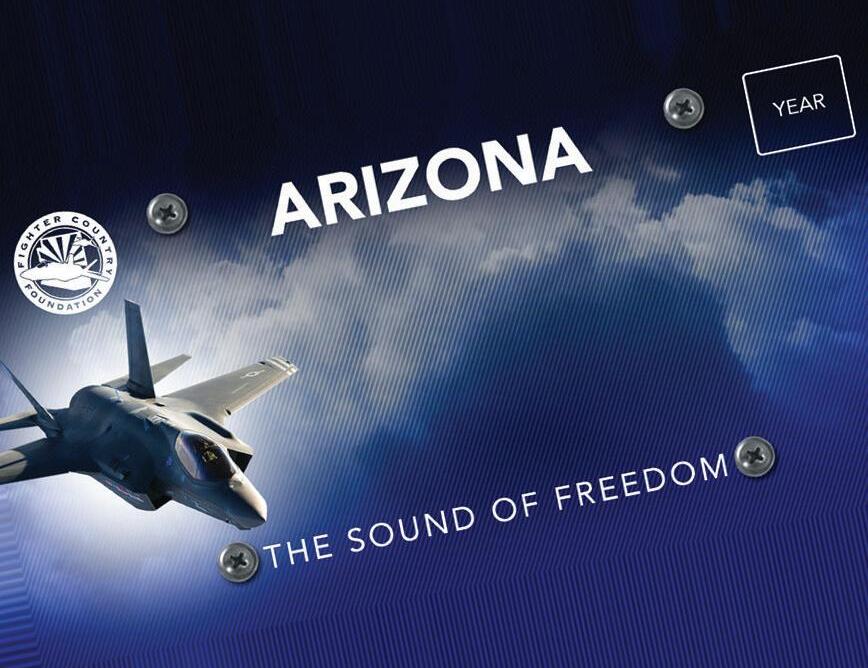
The Glendale Community College Veterans Services Center is a one-stop shop for veterans who want to transition from military life to civilian life through higher education. The Veterans Services Center’s academic advisers assist in planning academic paths, identifying federal and state benefit options, certifying education benefits, and connecting veterans with services, on and off campus.

In addition to Active Duty Military Tuition Assistance, the GCC Veterans Services Center services numerous different VA education benefits. The VSC also guides student veterans through degree planning as well as class selection and registration.









The academic advisers at the GCC Veterans Services Center are deeply knowledgeable on the countless scholarship and financial aid options that are available to veterans. The services that GCC provides are not limited to academics; as part of the career counseling, the advisors at the VSC will help veterans explore civilian career options and learn about job search tools.

The 56th Fighter Wing supported a U.S. Navy flyover, during the 2023 Super Bowl, at the State Farm Stadium in Glendale.
Every year the U.S. military supports one of the most watched sporting events in the world, fostering a long-standing partnership between the National Football League and military communities.

This year’s flyover commemorated 50 years of women flying in the U.S. Navy, while also serving as an opportunity for members of the Air Force and Navy to conduct a mission cooperatively.
“The Air Force has been absolutely amazing here at Luke,” says U.S. Navy Lt. Cmdr. Calli Zimmerman, assigned to Strike Fighter
Two U.S. Navy F/A-18F Super Hornets assigned to the “Flying Eagles” Strike Fighter Squadron (VFA) 122 out of Naval Air Station (NAS) Lemoore, California, soar at Luke Air Force Base. (Senior Airman Dominic Tyler/U.S. Air Force)
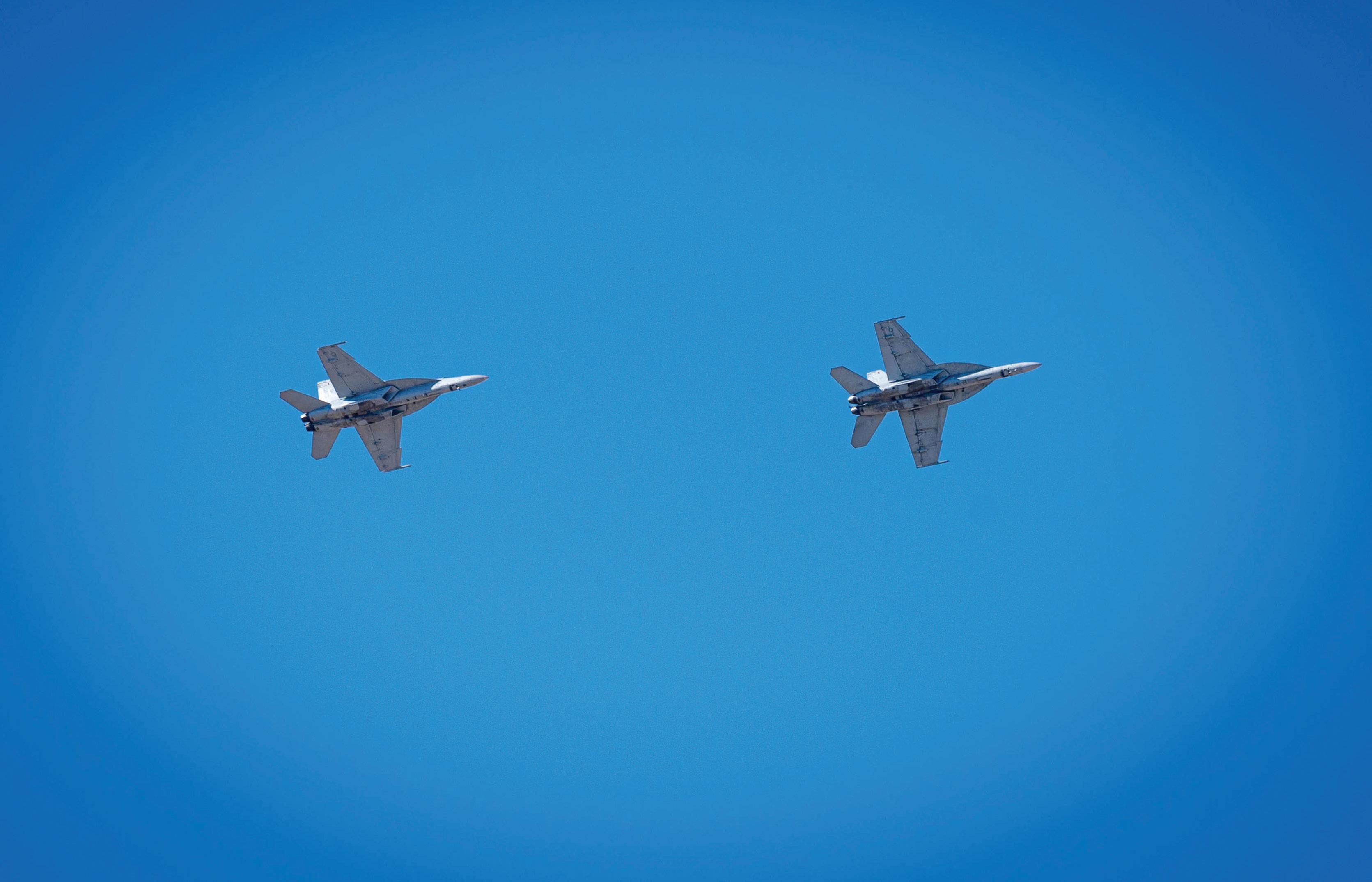
Squadron (VFA) 122 and one of the pilots involved in the flyover. “They have welcomed us with open arms, and since we got to Luke, everything has been seamless — from planning our arrival to the effort they’ve put forth since we’ve been here. We really couldn’t have done it without them.”
A large event, such as the Super Bowl, requires basewide support from Luke including security, medical, aircraft maintenance and other various base support operations. The week was an opportunity for Luke airmen to exercise working in joint scenarios and inte-
grate mission operations with their sister service’s personnel and aircraft.
“It’s not every day we get to work with our sister service,” says U.S. Air Force Tech. Sgt. Zach Vega, 56th Security Forces Squadron Pass and Registration noncommissioned officer in charge. “The ability to adapt and overcome in order to execute the mission anytime, anywhere is a key strength of our military and the 56th FW and USN did just that in coordinating a flawless event for the community.”
The 56th FW is also responsible for hosting
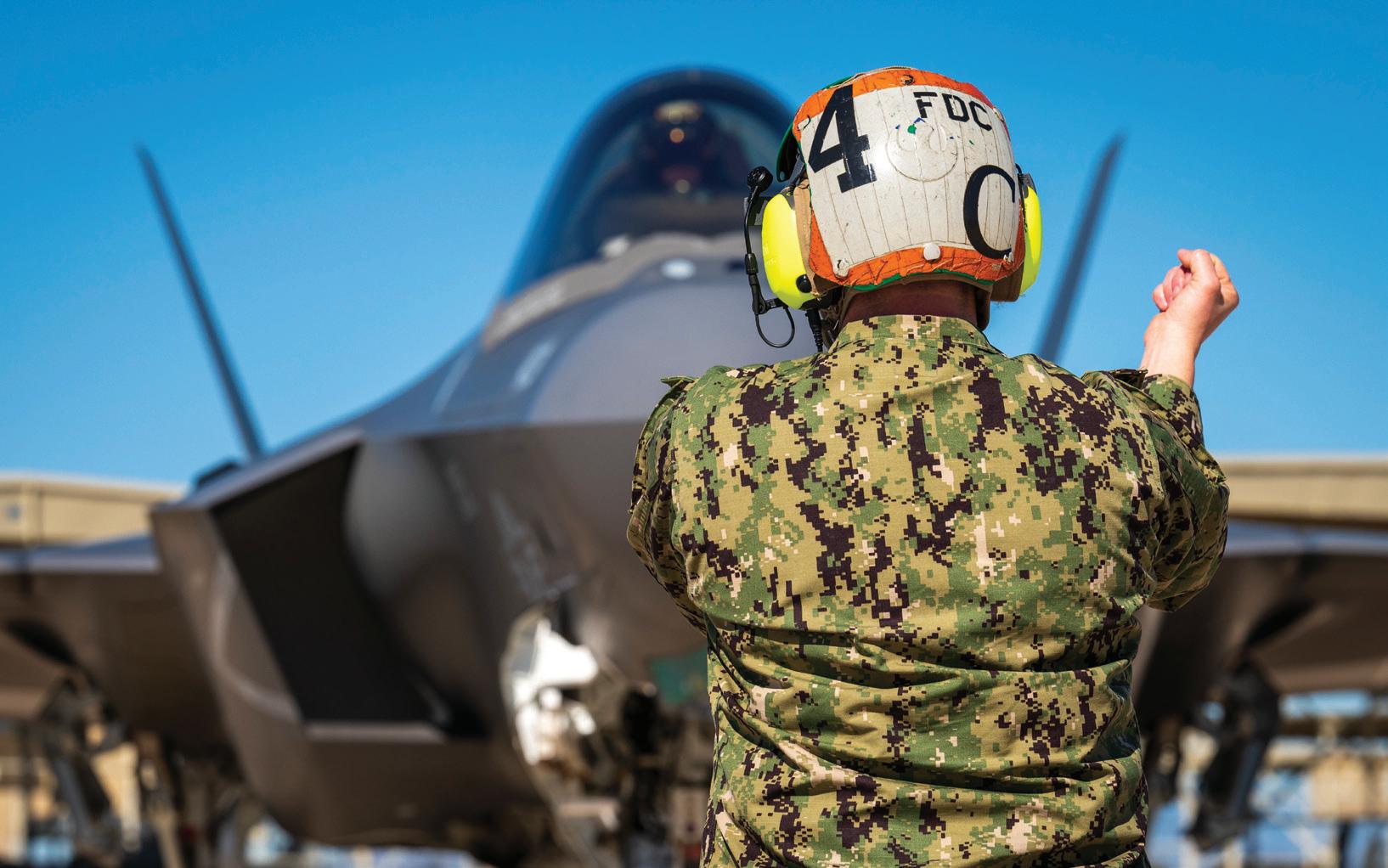
and participating in various events leading up to Super Bowl Sunday, including a Medal of Honor recipients panel, an NFL Hall of Fame event, a wheelchair championship football game and a celebrity flag football game. These events are an opportunity for airmen and families to celebrate and foster community relations between the base and the local community.
“The 56th Fighter Wing team extends beyond our gates,” says U.S. Air Force Brig. Gen. Jason Rueschhoff, 56th FW commander. “Our airmen, their families and our community partners are key to our mission here. It’s not every day the Super Bowl comes to Glendale, and Thunderbolt Nation is happy to host our USN partners here at Luke and thrilled that our airmen get to celebrate this event with the community.”
The 56th FW is comprised of multi-capable airmen who have the ability to adapt and integrate with sister services while still accomplishing the training mission every day.

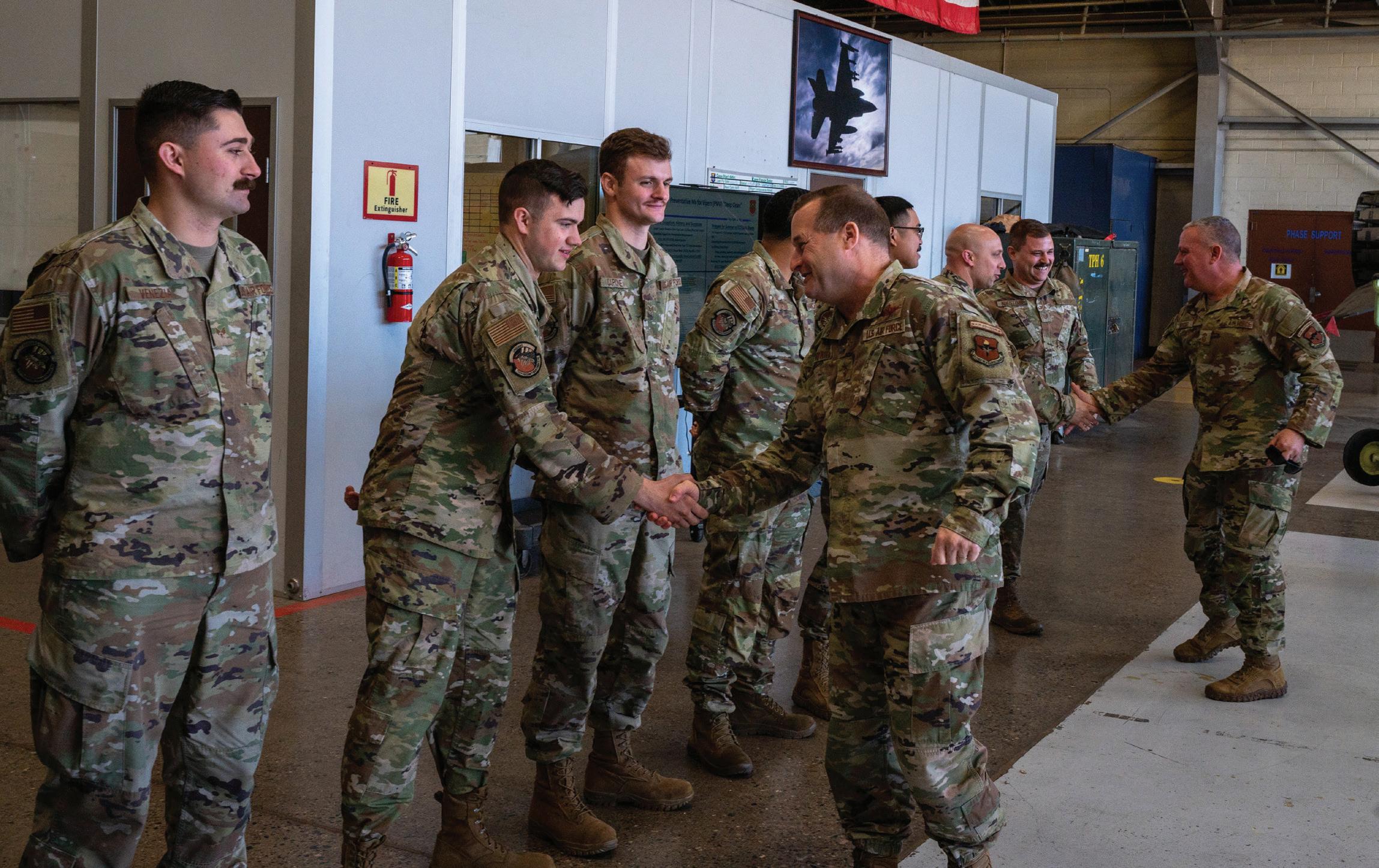 BY SENIOR AIRMAN DOMINIC TYLER 56th Fighter Wing Public Affairs
BY SENIOR AIRMAN DOMINIC TYLER 56th Fighter Wing Public Affairs
Maj. Gen. Phillip Stewart, 19th Air Force commander, and Chief Master Sgt. Justin Apticar, 19th Air Force command chief, visited Luke Air Force Base and engaged with Luke airmen to gain insight on the successes and challenges unique to the 56th Fighter Wing.
This is Stewart’s first visit to Luke after taking command of the 19th AF in August 2022.
During their visit, Stewart and Apticar toured premier fighter squadrons, aircraft maintenance units and base facilities including the 61st FS, the 62nd AMU and the 56th Maintenance Group munitions squadron.

At the 61st FS, Stewart spoke with pilots on the importance of Luke’s coalition training.
“One of the most important things to the Air Force is training integration with our coalition partners,” Stewart
says. “We fight side by side as a coalition, and Luke is shaping the future of F-35 training.”
After their tour of the squadrons, Stewart and Apticar held an All Call event where they introduced themselves, discussed their priorities and expectations, and fielded questions from airmen.
At the All Call, Chief Apticar spoke to supervisors about being front-line leaders for their airmen.
“Without trust, you’re just a supervisor,” Apticar says. “To be a front-line leader you have to build trust and communicate with your airmen. A front-line leader listens to their people and shows them respect so everyone has full capability to complete the mission.”
Later on, Stewart and Apticar met with Brig. Gen. Jason Rueschhoff, 56th FW commander, and Chief Master Sgt. Jason Shaffer, 56th FW command chief, as well as members of the Balfour Beaty Communities Housing Office to discuss initiatives and future plans surrounding the Luke AFB housing community.
“At the end of the day, we’re here to make our airmen’s lives better,” Stewart says.
“Holding town hall meetings gives us an opportunity to address the concerns of our people directly as well as discuss the best solution for problems.”
Stewart and Apticar culminated their visit with a briefing from the Community Initiatives Team. They visited with Luke AFB community and civic leaders to discuss extensive growth surrounding the base, the Auxiliary Airfields, and the actions taken to preserve Luke’s long-term mission.

The 19th AF commander thanked airmen and their families for their hard work and support while Luke continues the mission of training the world’s greatest fighter pilots and combat ready airmen.
The 19th AF oversees the 56th FW and is responsible for the training of more than 30,000 U.S. and international military students annually, in a variety of specialties including manned aircraft aircrews; remotely piloted aircraft crews; air battle managers; weapons directors; Air Force Academy Airmanship programs; and Survival, Escape, Resistance and Evasion specialists.
With over 25 years of Eldercare experience, our nationwide company provides seniors and their families with expert advice on long-term and senior housing



Assisted Living Locators is a FREE referral service. Our professional Eldercare Advisors provide personal assistance in locating the right options for your elderly loved one. An Eldercare Advisor can reduce your stress by providing a free consultation and help you find the right Home Care, Alzheimer’s/Dementia Care, Assisted Living, Nursing Homes and Retirement Communities. CALL 623-703-5326 For No Cost Referral Service FOUR

Airmen assigned to the 56th Fighter Wing at Luke Air Force Base showcased an F-35A Lightning II and F-16 Fighting Falcon at the Mesa Gateway Aviation Day.
Elementary school students from around
the Phoenix area were able to see military and civilian aircraft, try on flight equipment and learn about the life of U.S. Air Force pilots.
“The best part was getting to see those kids’ faces light up,” says Capt. Melanie Kluesner, 56th Operational Support Squadron instructor pilot. “As we talked about everything the F-35 is capable of, they realized that we do more than just fly fast, and they

were really amazed.”
The accompanying pilots and support team brought various pieces of flight gear, allowing the students to try on some of the equipment, while also teaching them about their use.
U.S. Air Force aircraft joined the 56th FW, including a T-38 Talon from the 509th Bomb Wing, and a KC-135 Stratotanker from the Hawaii Air National Guard.



 56th Fighter Wing Public Affairs
56th Fighter Wing Public Affairs
Five allied nation military personnel successfully graduated from the first official F-35 Partner Intelligence Formal Training Unit class at Luke Air Force Base.
The first of its kind, the F-35 PIFTU course is meant to expedite and improve intelligence training and collaboration between the U.S. and foreign partner nation intelligence organizations, specifically regarding F-35 Lightning II systems and capabilities. It was conceptualized in 2019 by Maj. Joy Lomheim Nguyen, U.S. Air Forces in Europe and Air Forces Africa Fifth Generation Interoperability Branch engagements officer, who recognized a need for such a course after becoming a
part of the F-35 program at USAFE.
“I began attending various engagements with F-35 counterparts and operators in the European theater,” Lomheim Nguyen says. “After several events, I noticed that not all issues, specifically regarding intelligence, were being fully accounted for and actioned.”
Lomheim Nguyen encountered multiple obstacles along her three-year journey while attempting to assemble the F-35 PIFTU course. Just when all hope felt lost, she found Maj. Kevin Hawkins, Joint Force Command Naples deputy theater collection manager, who immediately jumped on board to bring Lomheim Nguyen’s vision to life.
At the time, Hawkins was the 56th Operations Support Squadron wing intelligence chief at the 56th Fighter Wing, Luke AFB. The 56th FW is the largest fighter pilot training base in the U.S. Air Force with a robust international training mission.
“When Joy (Lomheim Nguyen) first reached out about creating a shared train-

ing course, we were all about it,” Hawkins says.
“Our team and leadership saw it as an amazing opportunity to help the United States and our allies operate better together in the future.”
Hawkins was already a part of intelligence training for personnel supporting F-16 Fighting Falcons, which meant he understood the impact a course like this could have on partner nations and the overall benefits that come with it.
“For a fighter unit to operate effectively, it’s a lot more than just flying the planes,” Hawkins says. “One of the most important background elements is intelligence support. In a fight, if our allies have learned about enemy capabilities or weaknesses, we’d want to be able to share that knowledge with them and vice versa.”

The course emphasizes and familiarizes intelligence personnel on radar, electronic warfare, infrared spectrum, low-observable principles, F-35 systems and capabil-
SEE PIFTU PAGE 42



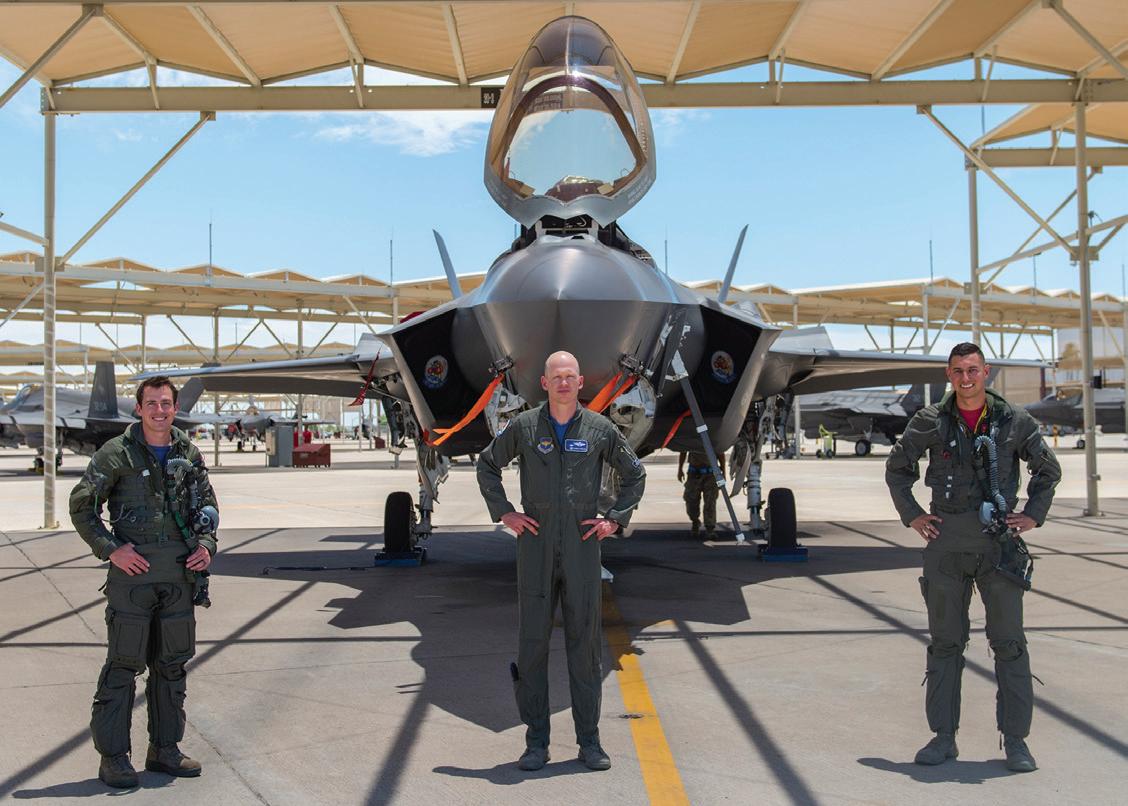













PIFTU










FROM PAGE










ities, F-35 air-to-air missions, F-35 air-to-ground missions, and mission planning to F-35 considerations.


Before seeing the first class attend the course he helped bring to fruition, Hawkins received orders for a new assignment and had to pass the torch to a new instructor. He passed it into the capable hands of Maj. Daniel Diamond, 56th OSS wing intelligence chief, and a team of individuals who are equally passionate about seeing this course and its students succeed.
“If we’re going to fight together and we’re flying the same planes, in the same air space, with the same objectives, then we need to be able to plan, coordinate and debrief together,” Diamond says. “That’s been a huge impetus to better develop our processes and collaboration.”
Pulling this off was no small feat, however. It was the drive and dedication of the small team of instructors as well as a much larger network of individuals at Luke AFB that made the F-35 PIFTU course come to life.
“Without Lt. Col. Jim Farrell (944th Operations Support Flight wing intelligence chief), Tech. Sgt. John Hemmerich (56th OSS F-16 Intelligence Formal Training Unit instructor), and Staff Sgts. Cortney Haralson and Aubrey Smith (56th OSS intelligence analysts), this course would truly not exist,” Diamond says.
“They took all of this on as a secondary duty, working with the Advanced Programs Office, the 56th Communications Squadron, foreign partner nations and foreign disclosure officers at Luke AFB and elsewhere, to make it possible for us to secure and set up a facility, build a syllabus and academics, refine coursework, build training scenarios, teach students, and so much more, all while performing their primary responsibilities for the 56th and 944th Operations Groups.”
The first class saw five students from Denmark, the Netherlands and Norway work together to graduate and forge lasting relationships for future endeavors. The students noted how the course could increase effectiveness within their air forces by creating more intelligence personnel who can support F-35 operations, as well as the benefit of meeting their counterparts in partner militaries.
Early exposure to multinational collaboration in the intelligence community can lead to more robust and faster interoperability. The ability to rapidly share information between ally nations is critical in a dynamic warfare environment. Establishing a baseline for intelligence sharing is a step toward seamless future integration, which is exactly what the F-35 PIFTU team at Luke AFB is aiming to achieve.
Although the course was hosted at Luke AFB and led by U.S. Air Force instructors, each student was able to share their unique, country-specific training with everyone involved. Lomheim Nguyen has high hopes for the future of the course.








During a visit to Arizona, the first lady of the United States, Dr. Jill Biden, took the time to personally thank and acknowledge the service of Luke Air Force Base airmen, highlighting the administration’s commitment to supporting military personnel. U.S. Air Force photographer Airman 1st Class Mason Hargrove captured the moments.



























































